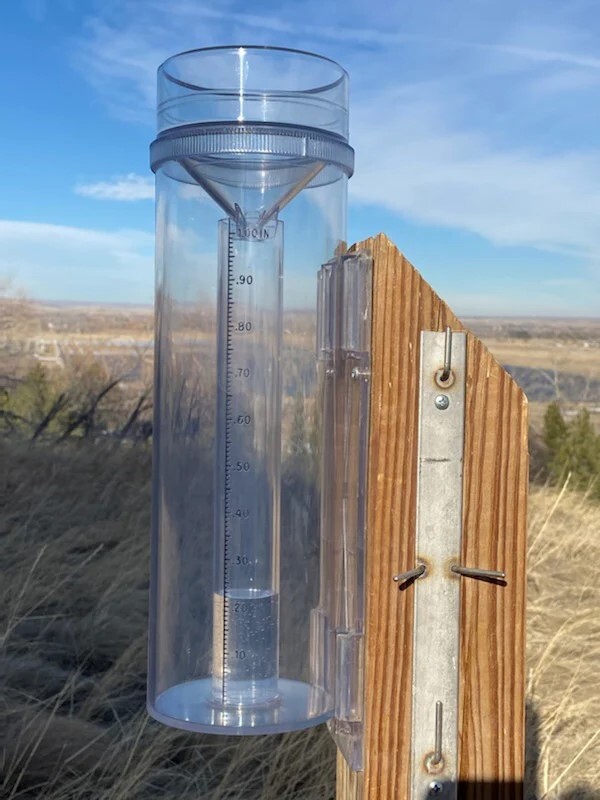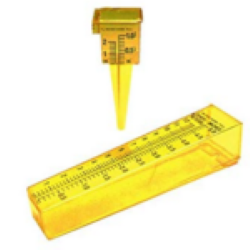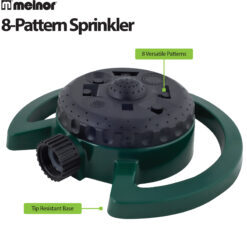Arbor Doctor May 2023 client update and latest blog postings

We are moving right through the last part of spring and nearing the beginning of meteorological summer. Isn’t it interesting how the first day of meteorological summer roughly corresponds with the Memorial Day weekend which is often thought of as the traditional first weekend of summer? My phones have been ringing off the hook and questions and issues abound in the plant health care realm. Common themes in my area include winter damage, the ubiquitous Needlecast on blue spruce (Picea pungens glauca), and drought damage from fall 2022.
Our team updates
We have been spending a great deal of time and resources on training and field visits. I have continually been impressed with the diagnostic skills of our team. We have a great core horticultural team this year of (left to right) Plant Health Care Specialist Ali Randall, Plant Health Care Team Lead Steve Middleton, Office Manager Diane Smith, Principal Owner Ron Rothhaas, Director of Operations Camille Rechel, and Plant Health Care Specialist Noah Riggs.
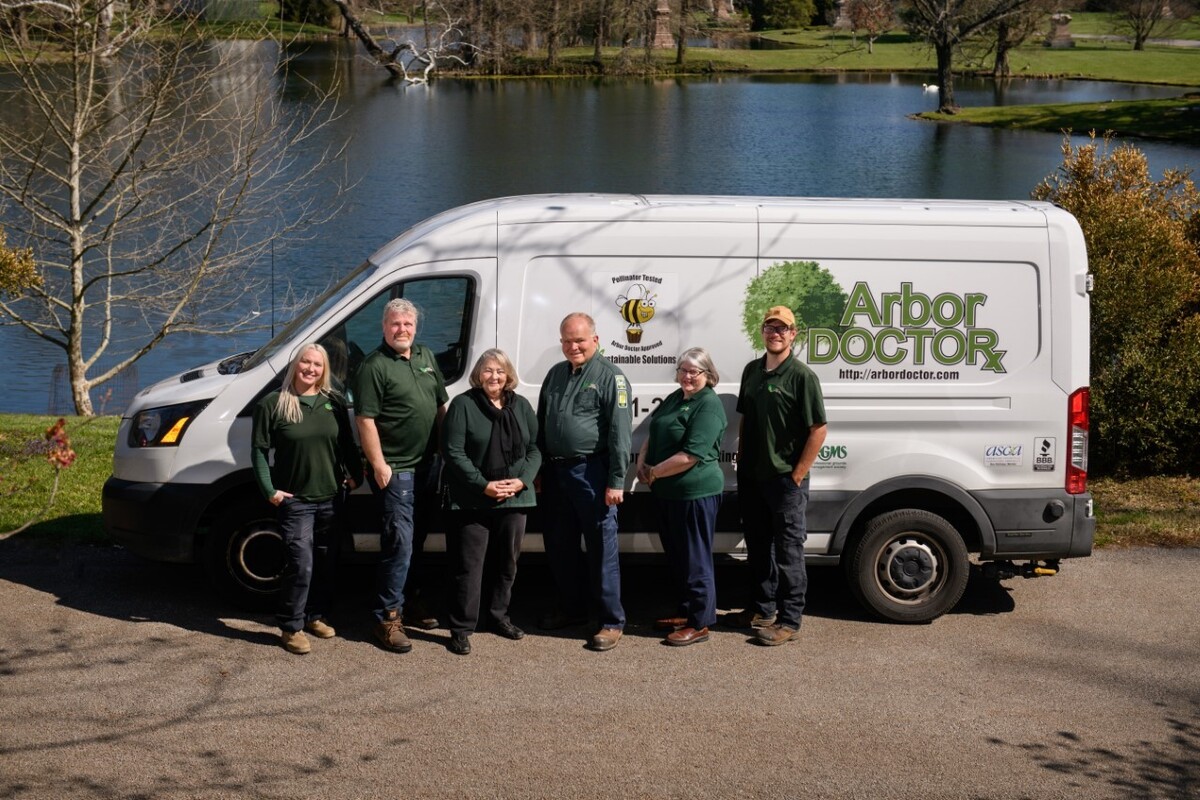
Arbor Doctor Updates
We are currently continuing to work on spring treatments, Emerald Ash Borer and Dutch Elm Disease treatments, spring fertilization, air knife and landscape jobs, bed weed control treatments and landscape installations. We are receiving a high volume of calls and requests and are following up as fast as we can. This is very definitely our busy season.
In the spring we often get questions about the timing of our treatments. Spring is a busy time because that is when much of the infection of leaf material occurs. To a large extent, fungal infection is prevented and not cured so more frequent treatment is often needed to do this efficiently. If we make frequent visits in the spring it is not because we are trying to add extra treatments but rather because we scheduled it that way for optimal effectiveness.
Also, infection happens in wet weather. We have found that waiting for perfect conditions often will allow for increased infection. We will always do our best to do what is right
For any questions or inquiries you may submit a request in our customer portal or contact Director of Operations Camille Rechel at 513-661-2673 or camille@arbordoctor.com

Freeze, Winter and Drought Damage Showing Up
We are getting many calls regarding evergreens not looking well. Remember, we had a drought in the fall but, even more importantly, we had that brutal and sudden attack of arctic air during the holidays. Many plants, including but not limited to cherry laurel, boxwoods, azaleas, shrub hollies, English Ivy, euonymus, evergreen magnolias, blue cedars, Japanese plum yews, and taxus are showing varying degrees of browning and foliage loss. This spring, we have had a several hard freezes which have killed new growth of many trees. These will mostly recover but it is taking time.
Winter Visits revealing winter damage, drought damage, and other things

Southern magnolias looking tired, but they will be fine
Until a couple decades ago, southern magnolia was not recommended for planting in Ohio. Then along came newer cultivars such as Bracken’s Brown Beauty, DD Blanchard and Edith Bogue. Before these newer cultivars came along, extended sub-zero cold would kill leaf and stem tissue. In the late 1970’s when air temperatures (not wind chills) in Ohio dropped to -25F and colder, many southern magnolias died completely or at least significantly.
Of these 3 cold hardy cultivars introduced in the years since, Edith Bogue seems to be the most cold hardy. For all 3, leaf burn begins when temperatures fall below zero. As temperatures fall to -10F and colder, leaf burn becomes more complete but bud and stem tissue can survive to even colder temperatures.
Since temperatures rapidly dropped below zero in December in Ohio, southern magnolia cultivars suffered some leaf burn and leaf drop. In all cases I have seen, bud and stem tissue appear to be healthy. However, these magnolias do not bud out until late May or June. In years like this, phones of green industry professionals start to light up about apparently unhealthy or apparently dead magnolias. In general, the trees are not unhealthy or dead, just delayed. Patience is the key and most of these trees will be just fine.
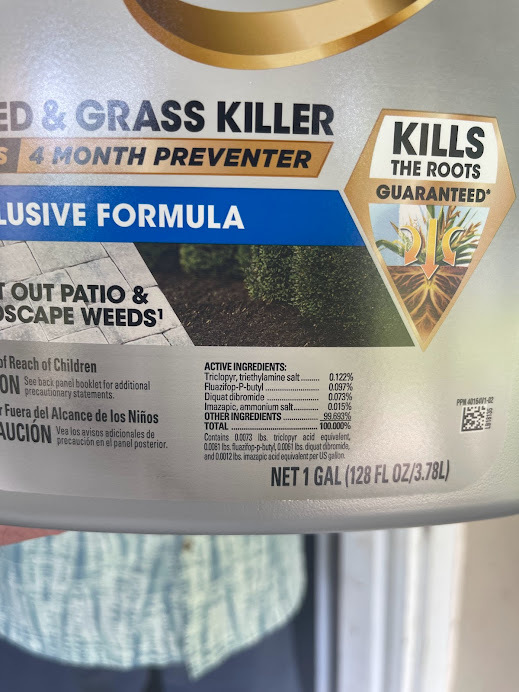
Caveat emptor. Dead all over again
As I was finalizing this issue of the newsletter I got a call from my team member, Noah, about a weeping willow (Salix babylonica) with a 6-inch trunk diameter which lost all its leaves a couple weeks ago, not long after the Roundup product pictured above was used to treat a stone area 4 feet from the trunk of the tree, and well within the root zone.
This is what drives me nuts about Roundup. For all the ambulance chasing, nonsensical claims we get regarding Roundup lawsuits and Glyphosate, the makers of Roundup seem almost desirous of shooting themselves in the foot. Notice that this Roundup product does not contain Glyphosate, but it does contain all the soil sterilizing, tree killing chemicals found in Roundup 365. Glyphosate can be used over the root zone of a tree but the mix of poisons in the pictured product label most certainly cannot.
Why do the makers of Roundup keep producing such dissimilar products under the same umbrella brand name?
Caveat emptor.
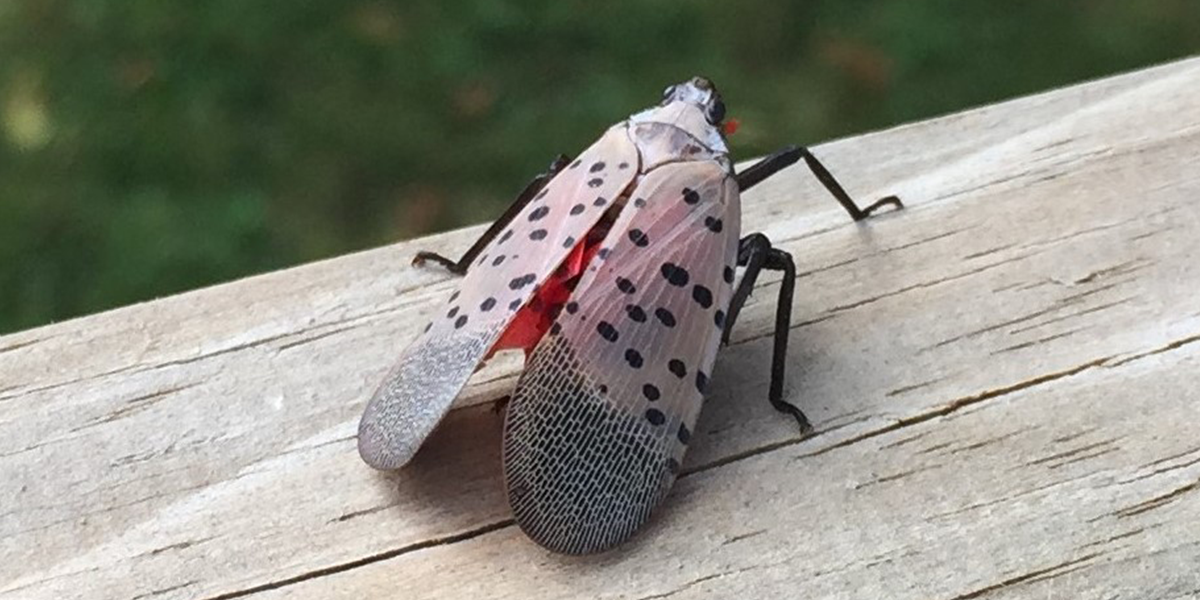
Unfortunate Arrival of the Spotted Lanternfly In Cincinnati
Adult lanternflies feed primarily on the non-native tree of heaven (Ailanthus altissima) and this plant seems to play a significant role in the lanternfly life cycle. Native wild grape (Vitus spp.) is another preferred plant. Young lanternflies (nymphs) can feed on a wide variety of species. Examples of crops that may be at risk from spotted lanternfly are grapes, hops, stone fruits (peach, plum, etc.) and apples; also possibly at risk for some damage are maple, walnut, poplar, willow, and others. In its native range, spotted lanternfly numbers are kept in check by parasitic wasps, but outside its native range the lanternfly can spread unchecked.
The Unfortunate Arrival of the Spotted Lanternfly in Cincinnati
It’s Getting Dry Out There.
Don’t forget to water when needed!
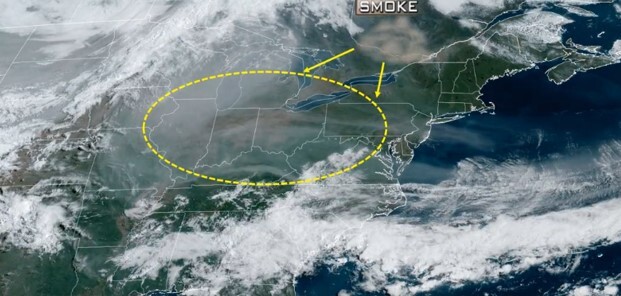
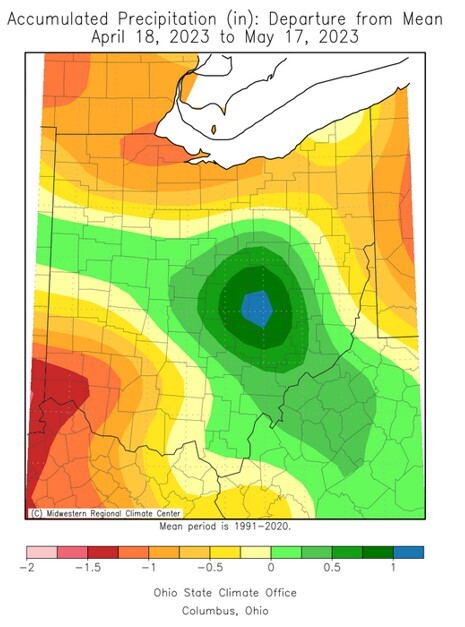
Over the past 30 days, conditions have been dry over southwest, northern, and northeast Ohio with wet conditions in central and southeast Ohio.
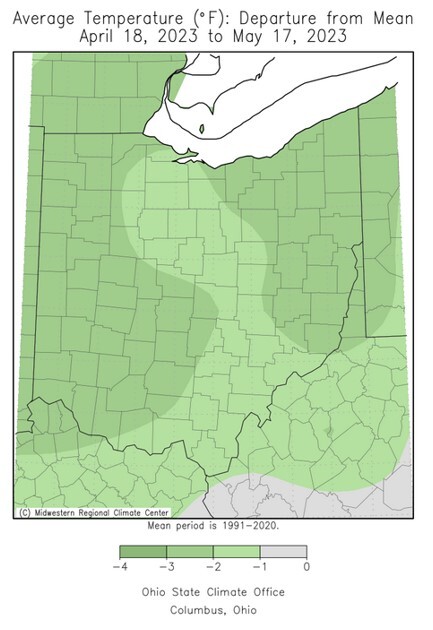
Temperatures have averaged well below normal over the past 30 days over much of Ohio, slowing the Growing Degree Day accumulation.
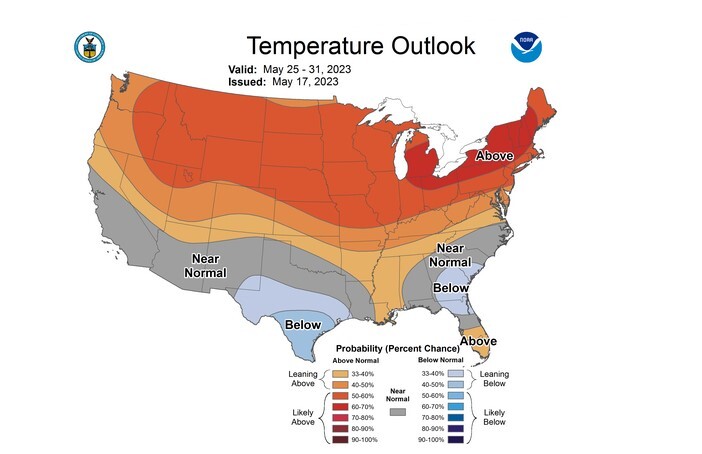
Temperatures are expected to become quite toasty over Ohio as we approach Memorial Day, the traditional start of summer, and the start of meteorological summer.
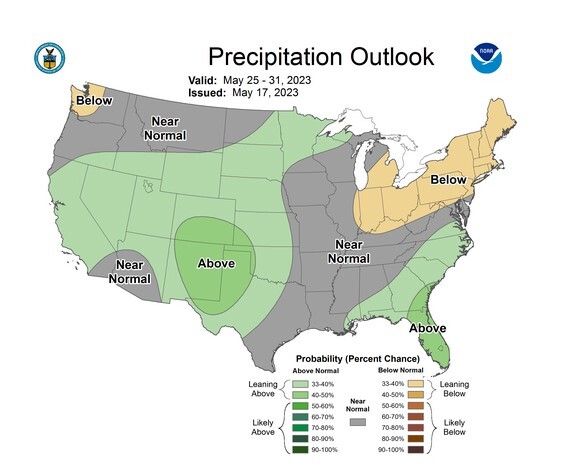
Rainfall over Ohio is forecast to be below normal through the end of May. It is already somewhat dry over parts of the state. Be sure to remind clients and customers of the importance of watering…correctly!
Please remember to water…correctly!
Water once per week, one inch per week, under the entire branch spread, in the absence of rain, May through November. Either rainfall or your watering should equal the one inch per week. Do not water if the soil is already moist. Put out a sprinkler and a straight sided soup can or rain gauge and measure one inch per week. Measure the rainfall which falls in your yard. Your trees don’t care what fell at the airport!
If burlap was left on new trees, it will repel water and the tree or shrub may die. Be sure burlap and twine are removed from the top of all root balls. If your landscaper disagrees, refer him or her to the American National Standards Institute (ANSI) industry standard for installation of landscape plants.
To the extent possible recycle fallen leaves back into the soil around the trees and maintain mulch around the trees to a radius of at least 3-5 feet. Keep mulch off trunks. Use a coarse textured mulch. Avoid triple shredded mulch. Aged arborist wood chips, mulched and composted leaves, pine bark, and pine straw are all good. Very finely ground mulches such as triple ground hardwood mulch are not beneficial and may inhibit moisture and oxygen exchange.
Updates posted on our blog pages over the past couple months:
Some additional thoughts from Ron
When I watch the news, which I try not to do very often, it seems as though our world has gone mad. Indeed, in many ways, it has. Sociologists will share that much of this craziness can be traced back to 2007. What happened in 2007? The introduction of the iPhone. No, it is not the iPhone specifically but rather the technology which allows us to be continuously connected.
Arbor Doctor is fortunate this year to have a really good team in place. It is difficult to find workers these days, as you likely have noticed. One statistic says for every 5 tradespeople who retire there are 2 to take their place. 7.2 million males ages 24-52 are not working and are not looking, ironically spending 2,000 hours a year playing video games like Call Of Duty.
Two people who I really respect, Dave Ramsey and Mike Rowe, teamed up recently to address this crisis in a live stream linked below. I urge you to give it a listen. It is eye opening, and explains a lot.
The Real Reason People Are Giving Up on Work | America’s Labor Crisis Live stream
Thank you for being a loyal Arbor Doctor client.
As always, feel free to call our Director of Operations Camille Rechel at 513-661-2673 with any questions.

Arbor Doctor LLC will be closed May 29, 2023, in observance of Memorial Day.
Have a blessed Memorial Day.
Sincerley,
Ronald E. Rothhaas, Jr.

